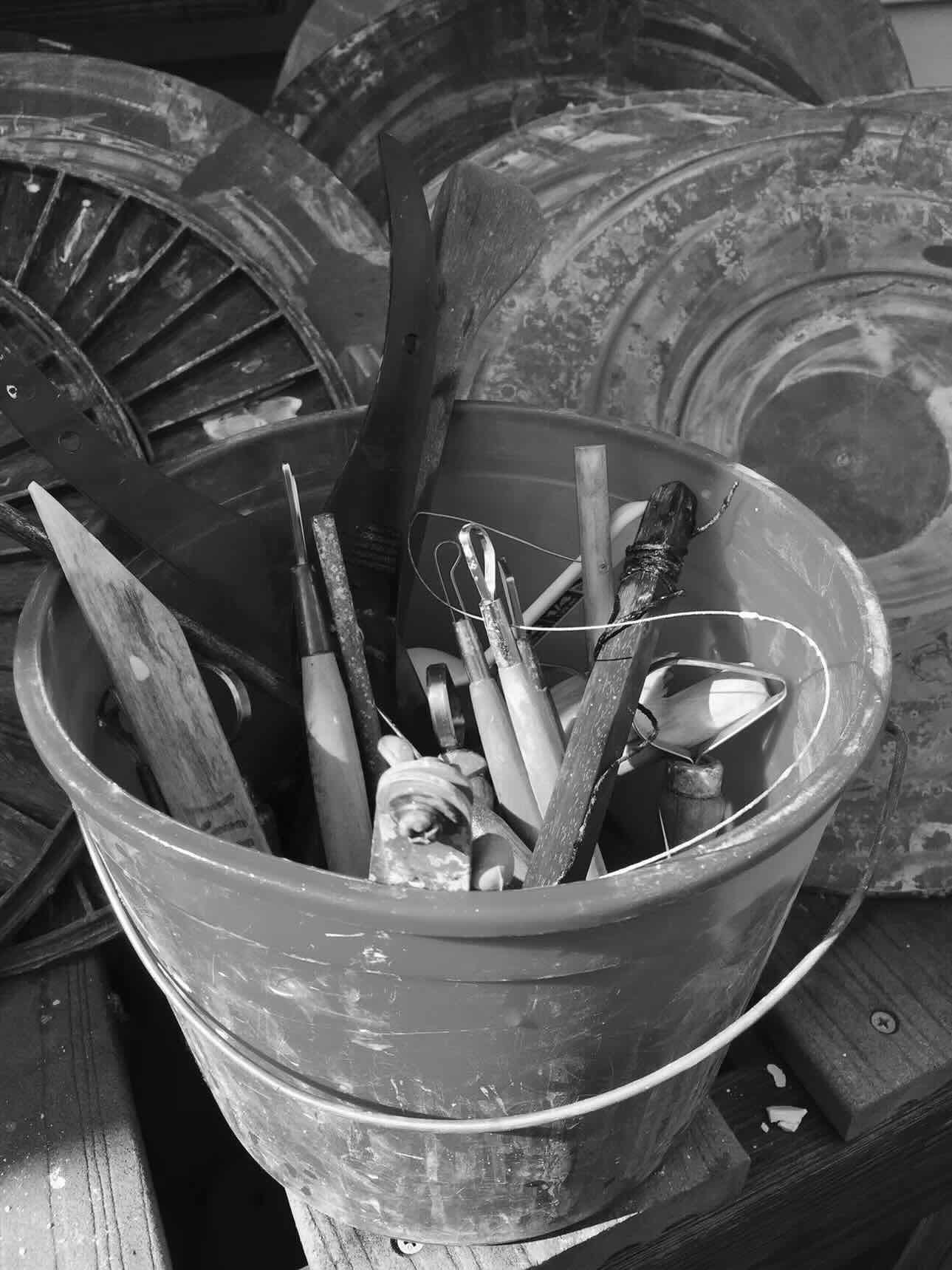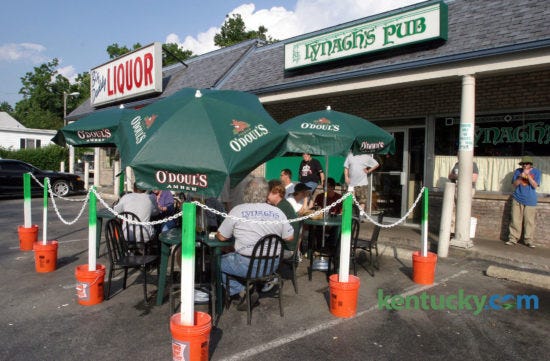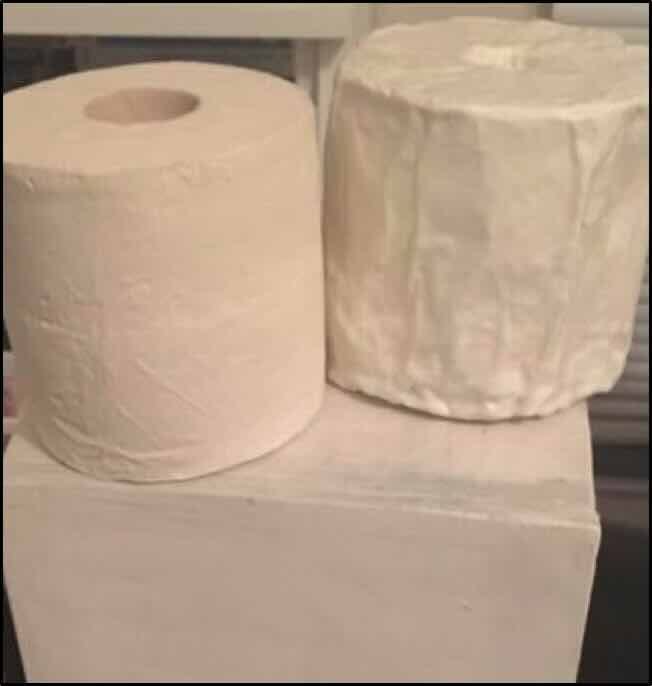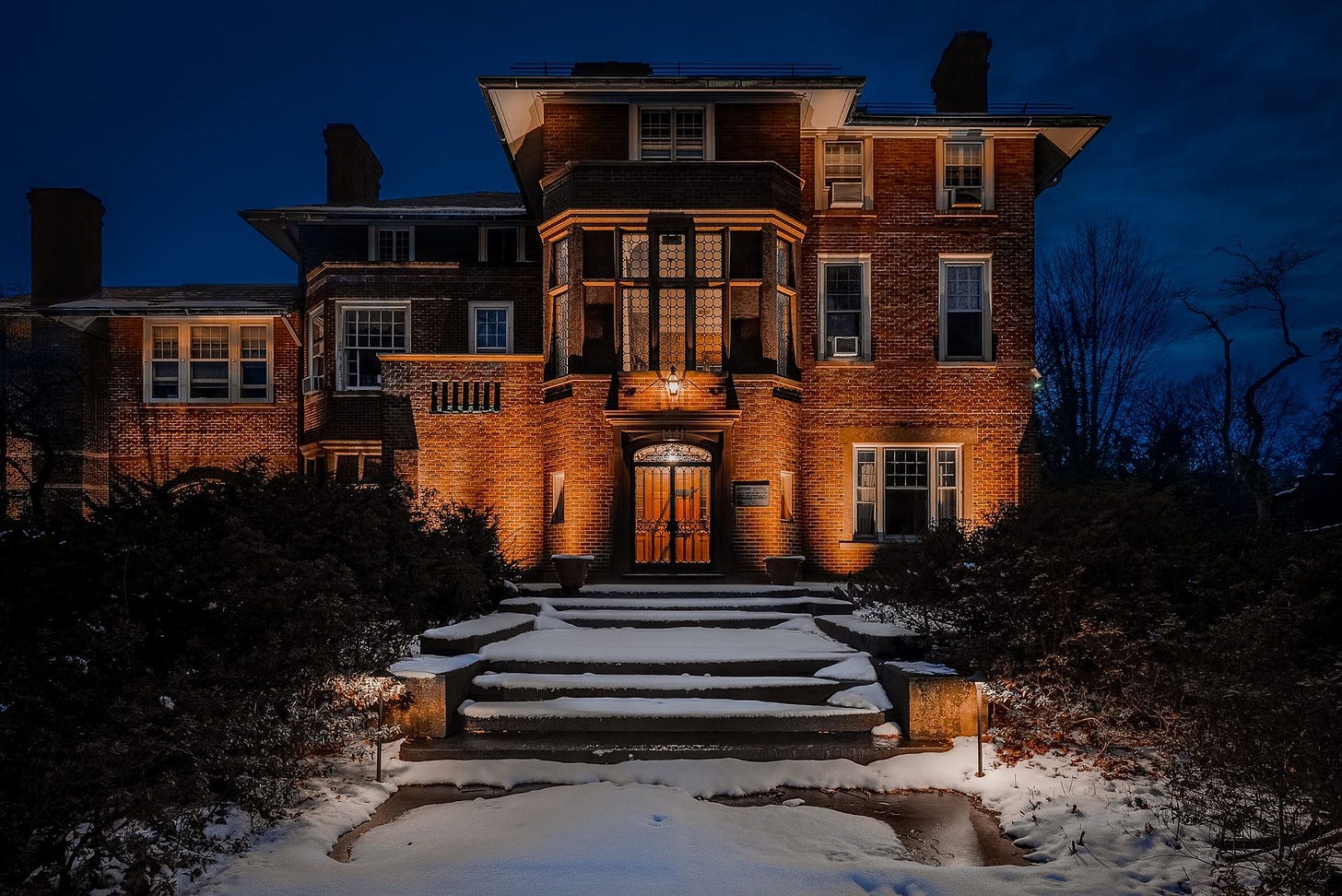When I started this newsletter early in 2021, during the pandemic, one of my many motivations was catching up with old friends who had drifted away for one reason or another.
I remember “Julie Carr” as a bottle-blonde art chick wearing cats-eye glasses, who smoked like a freight train and listened to Elvis. In those pre-Lilo days, my only exposures to The King were one hung-over visit to Graceland on a wedding weekend during undergrad and parodies like Eek! the Cat. I’m sorry to say I doubted my friend’s aesthetic wisdom. She had the patience and good grace to loan me her boxed sets and wait. I never warmed up to 70s Elvis in the sequined jumpsuit, but 50s songs like “No Room to Rhumba in a Sports Car” got my attention.
After 20+ years, I hardly recognized the distinguished interdisciplinary scholar with a PhD from Oxford described at her webpage and on LinkedIn
Everything connects. I have pursued a handful of fundamental questions in ceramics since my first pottery classes. Finally, last year, I completed an intellectual biography that I realized had successfully answered some of my earliest and most persistent questions. Looking back to my start, I remember the exhausting efforts I made every time I found a new book and looked for deeper explanations of what the word ceramics even meant.
Now, there's actually an answer that works. I wrote it.
until I got to her portfolio.

Today’s newsletter is the result of a month-long e-mail correspondence, which took me until now to digest (in multiple senses of the word).
Interviewing strangers is easy. They edit themselves because they don’t trust you to do it for them. With friends you haven’t seen in forever there’s so much to say, and so much reliance on shared memories, that there’s an interesting challenge to sorting it for outsiders.
Julia and I were both at UK at the same time, but we only met as fellow transplants in Rochester, NY. I was studying neuroscience and meditating at the Zen Center, and she was out at RIT studying ceramics. She took me to my first Japanese tea ceremony, put on by a member of a family firm that has been firing teapots and cups for something like 800 years.
This is hopefully the first of a series of sciencey interviews for the month of April, in honor of the NC Science Festival. Enjoy.
RH: I think you're doing more seemingly different things than I am. I have been in and out of academia for 20 years or more and through most of that have really struggled to find a niche that other academics could recognize as valid. I'm wondering about your experiences around that issue and how you've handled it.
JCT: As for academia and me -- it's been a lot, but mostly good in the aggregate. Your word "struggle" totally applies to my experience too. My MA thesis at UK in 2014 had the effect of truly pissing off one of my two thesis advisors to the point that she stormed out of her own office in the middle of one of our meetings while impressing the other, as well as paving the way for my doctorate in Oxford. Luckily Oxford exists for idiosyncratic scholars....I have such deep gratitude for that place and the people there. I would stay there permanently if I could, but it's also an incredibly intense kind of place, so maybe it's too much to stay there absolutely all the time.
. . . my work represents the first real discussion of ceramic science within the domain of the History of Science, so there aren't very many other scholars I can coordinate with on a regular basis, but I think my work begins to make space for itself gradually. I'm in the process of getting a book proposal or two together and hopefully finding a way of sustaining that process, too.
RH: Quick aside, I flipped through your online portfolio and the model bathroom jumped out at me and I have to ask about it. Was that life size? Did you carve something to look like a roll of toilet paper? What was that about?
JCT: aesthetically maybe that show was not my best moment -- but that bathroom installation came together in less than two months and lasted two weeks. Each 4'x8' wall panel weighed something like 300-500 lbs, I'm guessing, once the tiles went on. I threw them into a dumpster as soon as the show ended. (it took three men to lift each of them into the truck and then the dumpster.)
Everything was supposed to be handmade in some kind of ceramic material - -so I built a ceramic bathroom dispenser (condoms, perfume, aspirin, who knows??), and I slip cast some toilet paper. Just last night I thought about how cool it would have been to have little random scraps of wadded up paper towels and tissue made from porcelain laying on the floor! :D I only had time to make one roll of each kind of toilet paper, but I still have the molds in my storage unit. One of the rolls was cast while still in its paper wrapper, and the other was cast as the unused roll. I used spray paint on them first so that it would act as a resist against the plaster, but the one still wrapped in tissue kind of looked like it had gotten wet, possibly by falling into a toilet. That spoke to the reality of a bar bathroom, so I went with it.
The walls had a combination of graffiti that I had copied from bars and other public bathrooms, Lynagh's included. The others were other kinds of text I had written. I had to lay out the tiles in order and keep them that way through the whole firing process, a bit like a giant puzzle. That was at RIT in 1999. Basically my professors wanted some kind of a gallery show, and I had wanted to develop a line of custom tile for retail sales, so it was not exactly what I hoped. But it was certainly a noticeable project, in some ways. I still keep the TP and it occasionally gets mistaken for the real thing, so I count that as a success.
Ah, Lynagh’s. “The library,” in some UK circles. Where I saw my first live bands, the Metro Blues All-Stars being one of my favorites.

RH: The lack of cigarette butts on the streets was one of the things I found strange when I moved north. How did you quit?
JCT: why, HYPNOSIS, of course! I went to a session at a ballroom at the Marriott and haven't had a cigarette since. That was in late 1999 or early 2000. And I immediately gained enough weight to take away the lean artsy look and come up with something more suburban. :D Much healthier than living on nicotine, diet coke, and poptarts!! Though a bit more staid . . .
You asked how this transition to historian happened, and I always wanted to have some writing aspect to my career. I always thought fiction would be it, of course thinly veiled from the reality that seemed to verge on the surreal so much when it happened to me. But then my journals could never keep up with the rush and I didn't take any real notes and just used my experiences as stories to make my friends laugh the week after they happened, then I realized that maybe the same things happened to lots of people, and it didn't string into any kind of narrative. Then that fed into the ideas around the bathroom installation. I have some stories, but I find that the writing parts of the stories that really matter (because every life has them) was personally disrupting and Bridget Jones meets Less than Zero is not so much a narrative I'd want to spend time in anyway. Much easier then, to write about networks and lives in science and art in the background of the French Revolution....
Of course, taking that rock and roll and art energy into an engineering program in my 30s was some kind of mental training that has been incredibly useful.
RH: Engineering?
JCT: The thinking that I had at the time was, I wanted to learn Italian because I'd been watching all sorts of cooking shows while I was supposed to be at home painting and making pots, and I wound up cooking ALL the time so that I could watch shows about Italy. Ooops. But then, soon after, it was 9/11 and artists everywhere had to basically stop what they were doing because the market truly came to a standstill and I think it has struggled to recover ever since.
I worked at the Headley-Whitney Museum for a year then Wild Oats as a cheesemonger, so it was still collections and connoisseurship and cooking all the time!! :D The experience at the Museum told me that I need some kind of demonstrable expertise, and the Art History folks basically said there's no money, only "work for love" and the engineering folks said "six jobs for every graduate" so that was easy, except I'd never learned algebra, so the first year was excruciating until I could see all the steps people used to skip and leave me crying over. Then it was like "get out of my way". But I never was as fast as the people who'd just done math and science all of their lives. And there were other social factors. I kept my GPA up with language classes, and that seemed to hold it all together . . .
I didn't really quit engineering, but I'd gotten to a point where I could do some independent studies in the field that met personal goals, and I thought I would use the skills to teach other artists how to better understand their materials. But, after a class in Chinese ceramic history that was also an easy A to balance out the engineering grades, I got funding as a TA in art history. After that it's been one project into another, and when Oxford gave me a place, I didn't hesitate in any meaningful way. I didn't plan on it taking so long, which has been a not brilliant financial move, but I'd make the decision the same way without question.
RH: Geology is one of those things I wish I had found the time to study at some point. One of my favorite non-fiction pieces, "Rock Gods," was about that.
JCT: It's weird about geology -- I feel like it's one of those sciences that is benefitted by interdisciplinary thinking. I was interested as an undergrad, but it seemed to get too tedious too fast and I was too energetic to sit still for it at the time.
The blog about mineralogy was super interesting -- I hadn't heard of Hazen but his work sounds incredibly relevant. I'm going to have to read more -- especially as it involves clay mineralogy. Cool.
Agree also about the effort it takes to see any natural history museum and save energy for the minerals at the end. This year, when I was doing some research in Paris, I stayed across the street from the mineralogy gallery at the School of Mines in Paris, and I just couldn't get up the energy to go there - but it's amazing in the summer, as they have these big huge windows they open, because they don't have AC. All the displays are updated and modern in terms of curation, but they keep everything in a similar style to the 19th c displays, too. Creaky big-planked wooden floors. It's one of my favorite places anywhere.
RH: How are you on David Lynch? I had no idea he did so many different things.
JCT: Hey cool! You’ve made my day a great reading day. Love the cartoon portrait. I had a job interview today so I’m going to bed early with a book. Will catch up with the rest of this tomorrow.
Rock on, as it were.
[next day]
I wasn't really into David Lynch as a fan – I didn't watch a lot of Twin Peaks, but that's not all that surprising when you consider how little I watched TV anyway. But I recognize that he was one of those highly creative people whose work is a constant flow of expressions and ideas.
RH: This was a neat little essay on rocks (which reminded me of zen sitting).
How does one become a stone? Begin by sitting still. Let the world go on around you. Don’t move. Don’t cry. Write a bit, but do not speak. Sit out in the rain. Get cold. Warm up in the sun. Hum, but don’t sing. Let someone lean against you or sit on top of you. Bask. Don’t move.
Later it reflects on Oliver Sacks (also an Oxfordite(?)). He's one of the people who got me interested in neuroscience. I saw him speak twice, once in Rochester at the Academy of Medicine and once in Houston.
I didn't know this Phi Beta Kappa magazine. Stumbled across it doing a search for places to send my own writings. They pay better than most of my outlets and might be interested in your historical stuff.
JCT: The essay on rocks was really interesting!! Of course rocks have observable energy!! The last time I was out fossil hunting, I found that several of my fossils wanted to stay stuck to the matrix, even if they got separated. They bounce back into place, even if the bonds are light. The interactions are even more pronounced in some of the geological cores that I've processed, where pieces will spin back around or repel each other just like iron magnets. Though most of the core is dolomite or other kinds of limestone, I guess there is enough iron content to stay lightly magnetized, but of course lots of mineral crystals are polar, so I guess all of that is also a factor. Still, it's compelling when a fossilized brachiopod insists on returning to the place it has rested for 500 million years.
I got an electronic copy of the Raffles book just now! :D Planning also to read up some more on Oliver Sacks.... I think geology is one of those things you can appreciate better once you've had outside experience doing lots of other things . . .
I think I'm going to read some swashbuckling Dumas on the French Revolution now. Seems like a good afternoon for it.
Can’t really argue with that.

In Other News
Tonight (Monday the 7th) is our monthly game night at Gate City Growlers. Come on out if you’re local.








A podcast on Elvis as an archetypal healer / magician.
https://runesoup.substack.com/p/bathed-in-a-blue-suede-light
And even more Metro Blues. Caroline Dahl must have left by my time. I don't remember ever hearing any piano.
https://www.youtube.com/playlist?list=PLi3fgEfcad0CnLEl0FJ_RzPSDBOIF0IXI